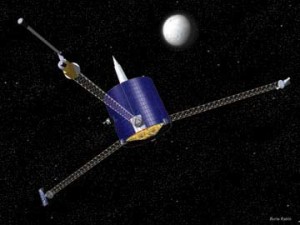Launched 19 years ago today was a mission to the moon that revealed something amazing – water ice at the poles.
Lunar Prospector. Image Credit: NASA
Launched on January 6, 1998 from Cape Canaveral, NASA’s Lunar Prospector began its journey toward the moon. The spacecraft’s three instrument booms deployed while cruising, and upon arrival, Lunar Prospector entered a near-circular polar orbit around the moon.
Image Credit: NASA
The mission indicated that a large quantity of water ice is present at both the north and south poles. One of the instruments onboard, the neutron spectrometer, found significant amounts of hydrogen in both of these areas – an indication of water.
Lunar Prospector gave us a more precise gravity map, taught us about the moon’s elemental composition, found mini-magnetospheres, and showed evidence of a small core being rich in iron. During its extended mission, the spacecraft’s orbit was lowered to gather higher resolution data. On July 31, 1999, the mission ended with the intended crash of the spacecraft into the lunar surface to see if water vapor could be liberated from the surface impact, but no plume was detected.
Lunar Prospector was part of NASA’s Discovery Program. The program launched smaller missions into space to improve our understanding of the solar system through missions that had shorter development times and used less resources.
Learn more about NASA’s Discovery Program at NASA.gov.


